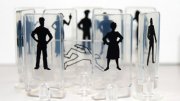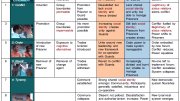
The ‘halo effect’ is a classic social psychology experiment. It is the idea that global evaluations about a person (e.g. she is likeable) bleed over into judgements about their specific traits (e.g. she is intelligent). Hollywood stars demonstrate the halo effect perfectly. Because they are often attractive and likeable we naturally assume they are also intelligent, friendly, display good judgement and so on.
The ground-breaking social psychological experiment of Festinger and Carlsmith (1959) provides a central insight into the stories we tell ourselves about why we think and behave the way we do. The experiment is filled with ingenious deception so the best way to understand it is to imagine you are taking part. So sit back, relax and travel back. The time is 1959 and you are an undergraduate student at Stanford University…
The Robbers Cave experiment, a classic social psychology experiment, has at least one hidden story. The well-known story emerged in the decades following the experiment as textbook writers adopted a particular retelling. With repetition people soon accepted this story as reality, forgetting it is just one version of events, one interpretation of a complex series of studies.» Read on about Sherif’s Robbers Cave experiment -»The famous ‘Stanford Prison Experiment’ argues a strong case for the power of the situation in determining human behaviour. Not only that but this experiment has also inspired a novel, two films, countless TV programs, re-enactments and even a band.
What social psychology experiment could be so powerful that simply taking part might change your view of yourself and human nature? What experimental procedure could provoke some people to profuse sweating and trembling, leaving 10% extremely upset, while others broke into unexplained hysterical laughter?
Many people quite naturally believe they are good ‘intuitive psychologists’, thinking it is relatively easy to predict other people’s attitudes and behaviours. We each have information built up from countless previous experiences involving both ourselves and others so surely we should have solid insights? No such luck.
People’s behaviour in groups is fascinating and frequently disturbing. As soon as humans are bunched together in groups we start to do odd things: copy other members of our group, favour members of own group over others, look for a leader to worship and fight other groups.
Bargaining is one of those activities we often engage in without quite realising it. It doesn’t just happen in the boardroom, or when we ask our boss for a raise or down at the market, it happens every time we want to reach an agreement with someone. This agreement could be as simple as choosing a restaurant with a friend, or deciding which TV channel to watch. At the other end of the scale, bargaining can affect the fate of nations.
In social psychology the ‘bystander effect’ is the surprising finding that the mere presence of other people inhibits our own helping behaviours in an emergency. John Darley and Bibb Latane were inspired to investigate emergency helping behaviours after the murder of Kitty Genovese in 1964.
Source: www.spring.org.uk
You might also like:




|
Social Studies Worksheets Don't Grow Dendrites: 20 Instructional Strategies That Engage the Brain Book (Corwin)
|



















 A social network is a social structure made up of a set of actors (such as individuals or organizations) and the dyadic ties between these actors. The social network perspective provides a clear way of analyzing the structure of whole social entities. The study of...
A social network is a social structure made up of a set of actors (such as individuals or organizations) and the dyadic ties between these actors. The social network perspective provides a clear way of analyzing the structure of whole social entities. The study of...
 The Faculty of Social and Political Sciences at the University of Cambridge currently houses four departments: Politics, Social and Developmental Psychology, Sociology and the Centre for Family Research. Each of these departments has a worldwide reputation for...
The Faculty of Social and Political Sciences at the University of Cambridge currently houses four departments: Politics, Social and Developmental Psychology, Sociology and the Centre for Family Research. Each of these departments has a worldwide reputation for...
 An interpersonal relationship is an association between two or more people that may range from fleeting to enduring. This association may be based on inference, love, solidarity, regular business interactions, or some other type of social commitment. Interpersonal...
An interpersonal relationship is an association between two or more people that may range from fleeting to enduring. This association may be based on inference, love, solidarity, regular business interactions, or some other type of social commitment. Interpersonal...
United states publishing
A psychological study on stereotypes done in 1988 by
Nigra, Hill, Gelbein, & Clark, ..
like this??